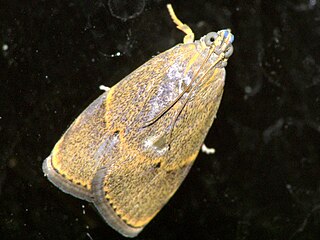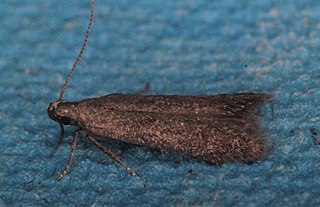
Falcaria lacertinaria, the scalloped hook-tip, is a moth of the family Drepanidae. The species was first described by Carl Linnaeus in his 1758 10th edition of Systema Naturae It is found in Europe and Anatolia then east to Eastern Siberia.

Paraswammerdamia lutarea is a moth of the family Yponomeutidae. It is found in Europe.

Hexadactilia trilobata is a moth of the family Pterophoridae described by Thomas Bainbrigge Fletcher in 1910. It is found in Australia in Queensland and New Guinea.

Sphenarches zanclistes is a moth of the family Pterophoridae that is found in Australia.

Imma mylias is a moth of the family Immidae. It is native to Sri Lanka, India, the Andaman Islands, the Philippines and Taiwan. It is an introduced species in Hawaii.
Eurhythma argyphea is a moth in the family Crambidae. It was described by Turner in 1913. It is found in Australia, in the Northern Territory.

Monochroa hornigi, the knotweed neb, is a moth of the family Gelechiidae. It was described by Otto Staudinger in 1883. It is found in most of Europe, European Russia, western and south-eastern Siberia, Transbaikalia, Korea and Japan (Hokkaido).
Stenoma camptospila is a moth of the family Depressariidae. It is found in Amazonas, Brazil.
Stenoma ancylacma is a species of moth of the family Depressariidae. It is found in Peru.
Antaeotricha trichonota is a species of moth of the family Depressariidae. It is found in Brazil and Paraguay.
Stenoma recondita is a species of moth of the family Depressariidae. It is found in Guyana.
Deltoplastis balanitis is a moth in the family Lecithoceridae. It was described by Edward Meyrick in 1910. It is found in southern India.
Odites carcharopa is a moth in the family Depressariidae. It was described by Edward Meyrick in 1914. It is found on the Comoros in the Indian Ocean.
Odites fruticosa is a moth in the family Depressariidae. It was described by Edward Meyrick in 1915. It is found in India.
Odites prosedra is a moth in the family Depressariidae. It was described by Edward Meyrick in 1915. It is found in Nigeria and the Democratic Republic of the Congo (Katanga).
Agriophara hyalinota is a moth in the family Depressariidae. It was described by Oswald Bertram Lower in 1899. It is found in Australia, where it has been recorded from South Australia and Queensland.
Antaeotricha plerotis is a species of moth in the family Depressariidae. It was described by Edward Meyrick in 1925. It is found in Peru.
Antaeotricha tornogramma is a moth in the family Depressariidae. It was described by Edward Meyrick in 1925. It is found in Brazil.
Imma psoricopa is a moth in the family Immidae. It was described by Edward Meyrick in 1906. It is found in Sri Lanka.

Tingena apanthes is a species of moth in the family Oecophoridae. It is endemic to New Zealand and found on the North Island. The adults are on the wing from October to December. It appears associated with Leptospermum species and it has been hypothesised that the appearance of the adults of this species imitates faded Leptospermum leaves.






